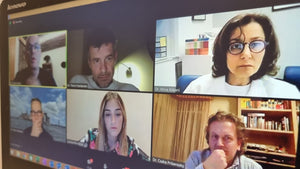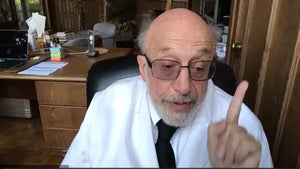
Session 128: THE FUTURE OF FREEZING PART 1

Donate
At the International IVF Initiative, we are committed to providing free access to our educational sessions, webinars, and resources for professionals and individuals passionate about advancing reproductive medicine. We believe that cost should never be a barrier to knowledge and collaboration. By contributing, you’re ensuring that valuable educational resources, expert insights, and collaborative opportunities remain open to all without financial barriers. Together, we can continue to foster a global community dedicated to innovation and excellence in the field of IVF.
Your Donation
Thank you!
Session 128: The Future of freezing Part 1
Tuesday, 5th March (3 pm EST / 8 pm UK / 9 pm
This webinar is kindly sponsored by Future Fertility
Synopsis:
Event Type: Educational Webinar
Moderators: Ms. Jullin Fjeldstad and Dr. Dan Nayot
"The Future of Freezing Part 1”, was a pivotal educational webinar aimed at shedding light on the latest advancements and future directions in the field of cryopreservation related to reproductive medicine. This event brought together experts to discuss innovative strategies in oocyte and embryo vitrification and warming, the long-term preservation of germ cells and gonadal tissues, and the comparative efficacy of vitrification versus traditional slow-freezing methods for ovarian tissue.
Presentations:
Dr. Juergen Liebermann - Fast and Furious: New Strategies in Oocyte and Embryo Vitrification and Warming
Dr. Liebermann presented compelling research on enhancing oocyte and embryo vitrification and warming processes. He introduced novel protocols aimed at increasing the efficiency and success rates of cryopreservation, emphasizing the critical role of rapid procedures in maintaining cellular integrity and viability. His work suggested that innovative approaches could significantly improve the outcomes of fertility treatments.
Dr. Pierre Comizzoli - Long-term Preservation of Germ Cells and Gonadal Tissues at Ambient Temperatures
Exploring an alternative to traditional freezing methods, Dr. Comizzoli's presentation focused on the feasibility of preserving germ cells and gonadal tissues at ambient temperatures. This ground-breaking research proposed methods that could simplify the storage and transportation of reproductive tissues, making preservation more accessible and reducing reliance on cryogenic temperatures.
Dr. Amir Arav - Techniques of Cryopreservation for Ovarian Tissue and Whole Ovary: Vitrification vs Slow
Dr. Arav delved into the nuances of ovarian tissue cryopreservation, comparing the outcomes of vitrification and slow-freezing techniques. His analysis provided valuable insights into the effectiveness of different cryopreservation methods, highlighting the potential benefits of vitrification in preserving ovarian function and fertility. This presentation underscored the importance of ongoing innovation in cryopreservation techniques to enhance fertility preservation efforts.
The webinar featured an engaging Q&A session, where attendees had the opportunity to interact with the speakers, posing questions about the practical implications of the presented research, technical aspects of the new protocols, and the future of cryopreservation technology in reproductive medicine. Discussions emphasized the transformative potential of these innovations, not only in improving clinical outcomes but also in making fertility preservation more feasible and effective for a broader range of patients.
Conclusion: "The Future of Freezing Part 1" was a landmark event that showcased the cutting-edge advancements in cryopreservation. By bringing together leading experts and fostering a dynamic exchange of ideas, the webinar illuminated the path forward for fertility preservation technologies. The insights and innovations shared during this session underscored the critical role of cryopreservation in reproductive medicine and the continuous need for research and development to overcome existing challenges and unlock new possibilities for patients worldwide.
Moderators:
Ms. Jullin Fjeldstad and Dr. Dan Nayot
Presenters:
Fast and Furious: New strategies in oocyte and embryo vitrification and warming- Dr. Juergen Liebermann
Long-term preservation of germ cells and gonadal tissues at ambient temperatures- Dr. Pierre Comizzoli
Techniques of Cryopreservation for Ovarian Tissue and Whole Ovary: vitrification vs slow-Dr. Amir Arav
Q and A
Ms. Jullin Fjeldstad
Jullin Fjeldstad began her fertility career at the Victoria Fertility Centre in 2007, quickly becoming a senior embryologist and successfully holding the position of laboratory director for several years. She has a BSc. in Biology from the University of Victoria, Canada and a MSc. in Clinical Embryology from the University of Leeds, UK; achieving distinction in both areas. She has always held a passion for innovative ART technologies aimed to improve the fertility journey and patient IVF outcomes. Today, Jullin is the Head of Clinical Embryology and Scientific Operations for Future Fertility. She works closely with partnering clinics to ensure smooth onboarding of innovative AI-based tools within their laboratories. Additionally, she oversees Future Fertility’s scientific project collaborations, bringing research findings to international fertility conferences.
Dr. Dan Nayot
Dr Dan Nayot is a practicing Reproductive Endocrinologist & Infertility (REI) Specialist at The Reproductive Care Centre in Canada and the Medical Director at The Fertility Partners, a North American network of IVF clinics. He is also the Co-Founder and Chief Medical Officer at Future Fertility. Dr. Nayot completed his BSc Mathematics at University of Toronto, MD at Western University, Master of Clinical Epidemiology at Harvard, FRCSC in ObGyn at University of Toronto, and REI Fellowship at McGill University. He is committed to innovation and data-driven research to optimize the patient experience and expand access to fertility care. With Future Fertility, he brings his extensive knowledge in medicine and mathematics together to solve the gaps he has experienced in over a decade of clinical practice.
Dr. Juergen Liebermann
Working in the field of IVF since 1995, Dr. Liebermann is the Director of Laboratory Services at the Chicago based Fertility Centers of Illinois partnered with the US Fertility | Ovation | RMA New York Network. He received his doctoral degree from the Technical University Munich in Bavaria/Germany in 1995 and his postdoctoral thesis in 2004 qualified him as a University Lecturer in Experimental Reproductive Medicine at the Bavarian University of Wuerzburg, Germany. He contributed more than 160 oral presentations at national and international meetings, and has authored more than 66 abstracts, papers book chapters in reproductive science. In 2007, and 2016 he co-authored a book with Dr. Michael Tucker titled Vitrification in Human Assisted Reproduction. He is a member of ASRM, ESHRE, and ABB. He also serves as an ad Hoc reviewer for Fertility & Sterility, Human Reproduction, Reproductive Biomedicine Online, and many more.
Dr. Pierre Comizzoli
Pierre Comizzoli started his career more 30 years ago as a research veterinarian in South America and Africa. He then completed a PhD in 2000 on in vitro fertilization in bovine and deer species. In 2002, he joined the Smithsonian’s National Zoo and Conservation Biology Institute in Washington, DC to develop new cryo-banking projects on gametes and gonadal tissues from rare and endangered species. He also coordinates reproductive monitoring and artificial inseminations in different species (including giant pandas, clouded leopards, or Eld’s deer). Since 2007, he is the Program Leader of a Smithsonian-wide initiative to improve the management and use of frozen biomaterial collections within the Institution.



































































































